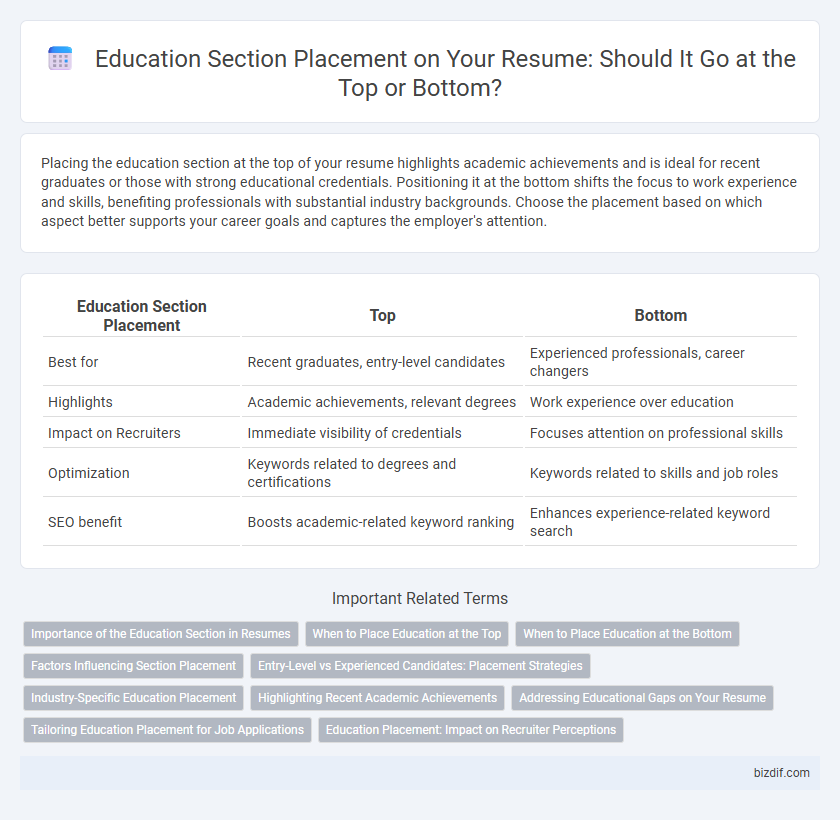Placing the education section at the top of your resume highlights academic achievements and is ideal for recent graduates or those with strong educational credentials. Positioning it at the bottom shifts the focus to work experience and skills, benefiting professionals with substantial industry backgrounds. Choose the placement based on which aspect better supports your career goals and captures the employer's attention.
Table of Comparison
| Education Section Placement | Top | Bottom |
|---|---|---|
| Best for | Recent graduates, entry-level candidates | Experienced professionals, career changers |
| Highlights | Academic achievements, relevant degrees | Work experience over education |
| Impact on Recruiters | Immediate visibility of credentials | Focuses attention on professional skills |
| Optimization | Keywords related to degrees and certifications | Keywords related to skills and job roles |
| SEO benefit | Boosts academic-related keyword ranking | Enhances experience-related keyword search |
Importance of the Education Section in Resumes
The placement of the education section in a resume depends on its relevance to the job; listing it at the top benefits recent graduates and those with strong academic achievements. For experienced professionals, placing education at the bottom allows work experience and skills to take precedence, emphasizing practical expertise. Highlighting degrees, certifications, and relevant coursework in the education section enhances resume impact by demonstrating foundational knowledge and qualifications.
When to Place Education at the Top
Place the education section at the top of a resume when you are a recent graduate or have limited professional experience, as this highlights your academic achievements effectively. Candidates with relevant degrees or certifications directly related to the job should also prioritize education to catch recruiters' attention. This strategy maximizes visibility of qualifications such as GPA, honors, and coursework essential for roles in fields like engineering, finance, and education.
When to Place Education at the Bottom
Placing the education section at the bottom of a resume is ideal for professionals with extensive work experience relevant to the job, as it emphasizes skills and achievements over academic credentials. Candidates with degrees earned several years ago or those changing careers benefit from highlighting professional expertise first. This strategy ensures recruiters prioritize practical experience and accomplishments that demonstrate suitability for the role.
Factors Influencing Section Placement
The placement of the education section on a resume depends primarily on the candidate's career stage and relevance of their academic background to the job. Recent graduates and individuals applying for roles that emphasize academic qualifications often benefit from positioning education at the top, ensuring recruiters quickly see their credentials. Experienced professionals typically place education at the bottom to highlight work history and skills first, leveraging practical experience as their primary qualification.
Entry-Level vs Experienced Candidates: Placement Strategies
Entry-level candidates benefit from placing the education section at the top of their resume to highlight recent academic achievements and relevant coursework, capturing employers' attention early. Experienced candidates should position education near the bottom, prioritizing professional experience, skills, and accomplishments that demonstrate industry expertise. Tailoring placement based on career stage ensures the most impactful presentation of qualifications to hiring managers.
Industry-Specific Education Placement
Placing the education section in a resume depends heavily on industry norms and relevance to the job. Technical fields such as engineering or IT often prioritize education at the top to highlight specialized degrees or certifications, while creative industries like advertising or design may place education at the bottom to emphasize portfolios and experience. Tailoring education placement based on industry-specific expectations enhances the resume's impact and aligns with hiring managers' preferences.
Highlighting Recent Academic Achievements
Placing the education section at the top of a resume effectively highlights recent academic achievements, making it ideal for recent graduates or individuals with strong educational credentials. For experienced professionals, positioning education at the bottom shifts focus toward work experience while still acknowledging academic background. This strategic placement enhances readability and aligns the resume with industry expectations to maximize impact.
Addressing Educational Gaps on Your Resume
Placing the education section at the top of your resume highlights academic achievements and is ideal for recent graduates or candidates with strong educational backgrounds. Positioning education at the bottom is beneficial for experienced professionals, emphasizing work history while minimizing educational gaps. Clearly addressing any educational gaps through brief explanations or relevant coursework within the education section enhances transparency and maintains employer confidence.
Tailoring Education Placement for Job Applications
Placing the Education section at the top of a resume is ideal for recent graduates or candidates applying for roles that highly value academic credentials, such as research or entry-level positions. For experienced professionals, positioning education at the bottom emphasizes relevant work history and skills, tailoring the resume to highlight practical expertise that aligns with job requirements. Tailoring education placement based on career stage and job focus ensures the most impactful presentation, optimizing recruiters' attention on the most pertinent qualifications.
Education Placement: Impact on Recruiter Perceptions
Positioning the education section at the top of a resume highlights academic achievements and immediately signals relevant qualifications to recruiters, which can be crucial for recent graduates or candidates shifting careers. Placing education at the bottom often emphasizes work experience, suggesting a stronger focus on professional accomplishments and practical skills valued by hiring managers in experienced candidates. Recruiter perceptions are influenced by this placement, as strategic positioning aligns the resume content with job requirements and candidate strengths, optimizing overall impact.
Education Section Placement: Top vs Bottom Infographic

 bizdif.com
bizdif.com